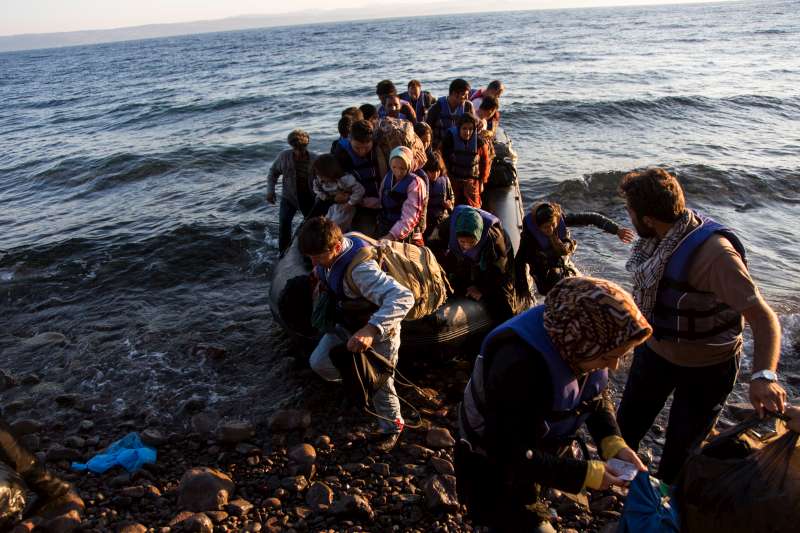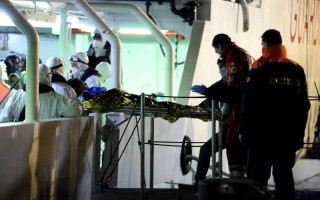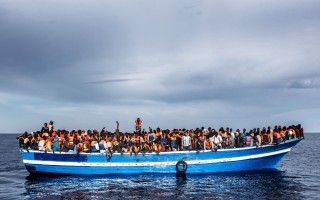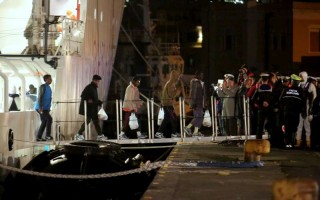
A group of Afghans recently arrive on the island of Lesbos after travelling in an inflatable raft from Turkey to Greece. More than 300,000 refugees and migrants have used the dangerous sea route across the Mediterranean so far this year. © UNHCR / A. McConnell
GENEVA, Aug 28 (UNHCR) – More than 300,000 refugees and migrants have used the dangerous sea route across the Mediterranean so far this year with almost 200,000 of them landing in Greece and a further 110,000 in Italy.
The UN refugee agency, revealing the latest statistics in Geneva on Friday, said this represents a large increase from last year, when around 219,000 people crossed the Mediterranean during the whole of 2014.
“At the same time, some 2,500 refugees and migrants are estimated to have died or gone missing this year, trying to reach Europe. This death toll does not include yesterday’s tragedy off Libya where numbers of deaths are still unconfirmed,” UNHCR spokesperson Melissa Fleming told a press briefing in Geneva.
Last year some 3,500 people died or were reported missing in the Mediterranean Sea.
Fleming said that despite the concerted efforts of the joint European search and rescue operation under FRONTEX, which has saved tens of thousands of lives this year, the Mediterranean Sea continues to be the “deadliest route for refugees and migrants”.
She added that in the last few days, even more people had lost their lives in three separate incidents.
The Libyan Coast Guard carried two rescue operations on Thursday morning, seven miles off the port town of Zwara. Two boats carrying an approximate total of 500 refugees and migrants were intercepted and survivors taken to shore in Libya.
“An estimated 200 people are still missing and feared dead. A still undetermined number of bodies were recovered and taken to shore. The Libyan Red Crescent has been helping with the collection of the bodies,” Fleming added.
On Wednesday (26 August), rescuers coming to the aid of another boat off the Libyan coast found 51 people dead from suffocation in the hold.
“According to survivors, smugglers were charging people money for allowing them to come out of the hold in order to breathe,” Fleming detailed.
She quoted one survivor, Abdel, 25, from Sudan as saying: “We didn’t want to go down there but they beat us with sticks to force us. We had no air so we were trying to get back up through the hatch and to breathe through the cracks in the ceiling. But the other passengers were scared the boat would capsize so they pushed us back down and beat us too. Some were stamping on our hands.”
Fleming said that last week (15 August), the bodies of 49 persons were found in the hold of another boat in a similar but separate incident. They are thought to have died after inhaling poisonous fumes.
Also that week, a rubber dinghy carrying some 145 refugees and migrants ran into trouble when the person steering it made a manoeuvre that caused the dinghy to tilt dangerously to one side.
“Some people fell into the sea and two men jumped into the water to rescue them. Panic ensued and people began to jostle and shove and, as a result, three women were crushed to death on the dinghy,” Fleming said.
Of those who fell in the water, 18 are still missing and believed to have drowned. The survivors were rescued and taken to Lampedusa, including a two-month old baby of one of the women who died. Most of the survivors are reported to be in a critical condition, suffering from shock, cuts and bruises.
Many of the people arriving by sea in southern Europe, particularly in Greece, come from countries affected by violence and conflict, such as Syria, Iraq and Afghanistan; they are in need of international protection and they are often physically exhausted and psychologically traumatized.
UNHCR appeals to all governments involved to provide comprehensive responses and act with humanity and in accordance with their international obligations.
All European countries and the EU must act together in response to the growing emergency and demonstrate responsibility and solidarity.
By Melissa Fleming





